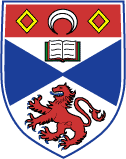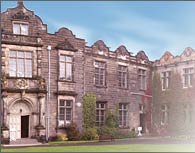
Return to my Societe Pages index
Return to the School Main Index: VCIndex1.htm
Return to the reminiscences page here.

LETTER FROM ST. ANDREWS
"But howsoever rich the store, I'd lay it down, To feel upon my back once more. The old red gown." - ROBERT FULLER MURRAY (1863—1894).When I left Victoria College to become an undergraduate at St. Andrews University, I was warned to take with me all the warm clothing I could muster — this winter has shown exactly how wise that warning was. The wind does indeed blow straight off the Russian steppes . . .
St. Andrews, as every golfer will know, lies on the east coast of Scotland just to the south of Dundee. The train from Edinburgh will take you as far as Leuchars — and no further, thanks to Dr. Beeching's cuts of 1968. From there a bus or taxi will drive you into St. Andrews. The town itself is full of character and historical interest. Some of the buildings are centuries old and the main street still retains its cobble stones.
The Cathedral ruins are a centre of attraction — as well as a base for action on Halloween Night — and the old Castle provides the setting each year for the May revels.
The University was founded at the beginning of the fifteenth century — only Oxford and Cambridge can rival it in age. It consisted of three colleges: St. Salvator's, St. Leonard's and St. Mary's. St. Salvator's and St. Leonard's were united during the course of the University's history and St. Leonard's lost its buildings which were sold to form a girls' school. St. Mary's was restricted to the study of Theology. The United College and St. Mary still exist, though they differ from Oxbridge colleges in that their quads, are surrounded solely by lecture theatres and tutors' rooms — undergraduates' accommodation is provided by separate Halls of Residence and student flats.

The University chapel runs along one side of St. Salvator's quad. and contains one of the finest organs of its kind in Britain.

Each department of the University is contained within its own building. These departments are spread throughout St. Andrews with the result that 'town' and 'gown' are thoroughly integrated. The science departments are grouped in a new complex while the department of the Arts Faculty, representing the more traditional disciplines, occupy the more central, older buildings. Much development is still going on — a new Library and an Arts and Crafts Centre have just been opened.
With only three and a half thousand students, the University must be considered small by comparison with many of the more modern establishments further south. This means that one very quickly feels oneself to be a member of the community. From the very day the new undergraduate arrives, the emphasis is laid by the members of the student body and by the academic staff alike on personal contact. Each student has the option of 'adopting' a third or fourth-year student of either sex as his 'parent' who will offer guidance and help during the First year. The system develops until he discovers he has a complete 'family' of 'brothers', 'sisters', 'uncles' and 'aunts' — in this way he is put into contact with people throughout the University at the very start. The integration of 'town' and 'gown' means that there are also many opportunities for contact with people from outside the University which can prove to be a refreshing and beneficial outlet.
Every University has its traditions and St. Andrews is no exception. Perhaps the most well known is the wearing of the red, undergraduate gown on official occasions — although since the gown is made of a fairly heavy material, it also has a more practical use. Some of the University traditions date back many years — for instance, the traditional walk to the end of the pier in gowns every Sunday morning, originally to say goodbye to the visiting preacher — some are of more recent foundation and the student can take part to whatever extent he feels inclined.
St. Andrews provides the usual blend of concerts, debates, talks and theatrical productions to be found in any University. For the more energetic there are sporting facilities which, I am told, compare favourably with those elsewhere. The summer term — during which, contrary to popular opinion, the weather is usually fine and warm — provides an opportunity for excursions into the surrounding countryside. At the weekend, .the Student's Union forms one centre of activity — it is perhaps just worth mentioning that St. Andrews withdrew from N.U.S. in 1976 and now maintains its own independent Union.
Academic life at the University revolves around a daily timetable of lectures and tutorials. The honours degree course in the Arts Faculty — which is all I am qualified to write about — lasts four years and leads to an M.A. The student follows three different courses in his first two years and then takes one of these on to an Honours course in the third and fourth years. This system seems to me to have several advantages: the number of subjects taken in the First two years lends a broad, more general base to the degree; it gives the student chance to take a subject in which he is interested but has not as yet had the opportunity to study; and it means that the choice of an Honours subject does not have to be made immediately — entry to the University is made through the relevant Faculty, not through a particular Honours course. The student is assessed in his first two years partly on the essays and exercises handed in during the term and partly on the result of terminal examinations.
The First two lines of the University song read —
"Gaudeamus igitur, Iuvenes dum sumus. . ."which in translation is:
Let us rejoice, therefore, whilst we are young For after joyful youth, old age shall gnaw at us and the earth shall have us.In St. Andrews that sentiment becomes a reality for in this old town each student has the prospect of spending an enjoyable and profitable four years.
ALAN HAMEL